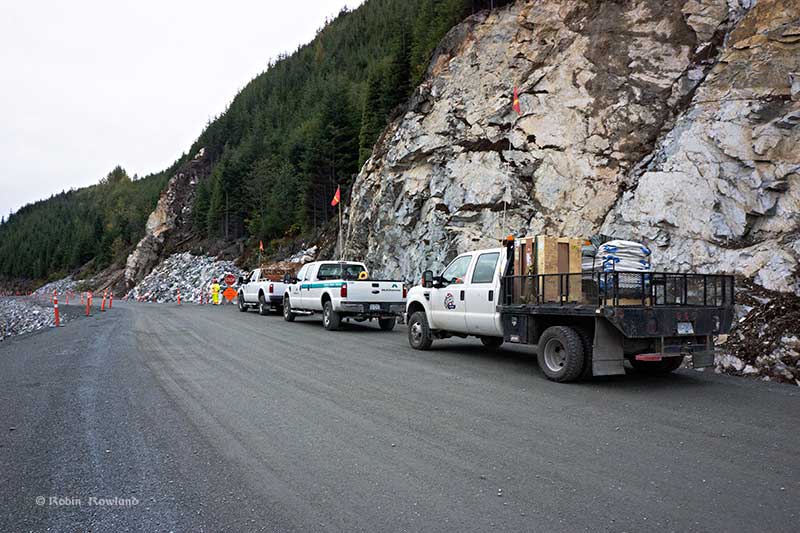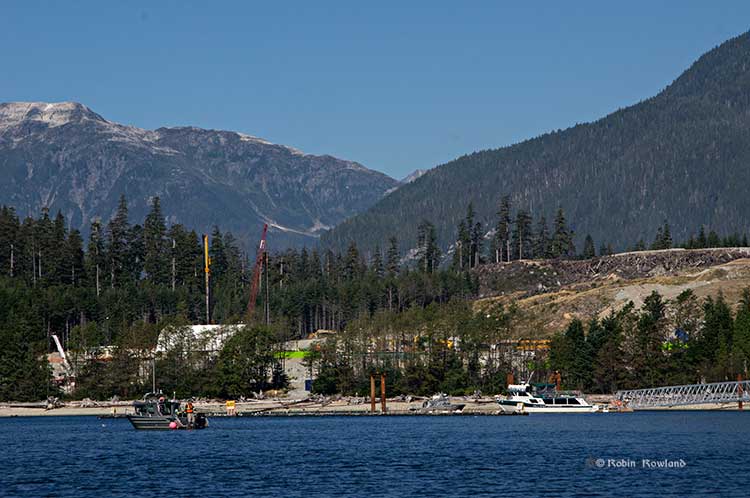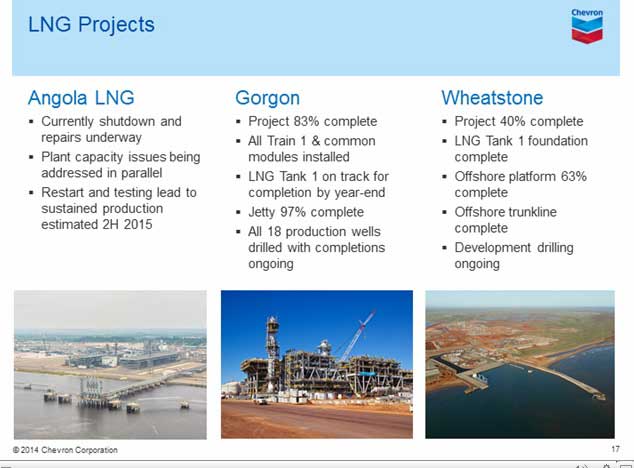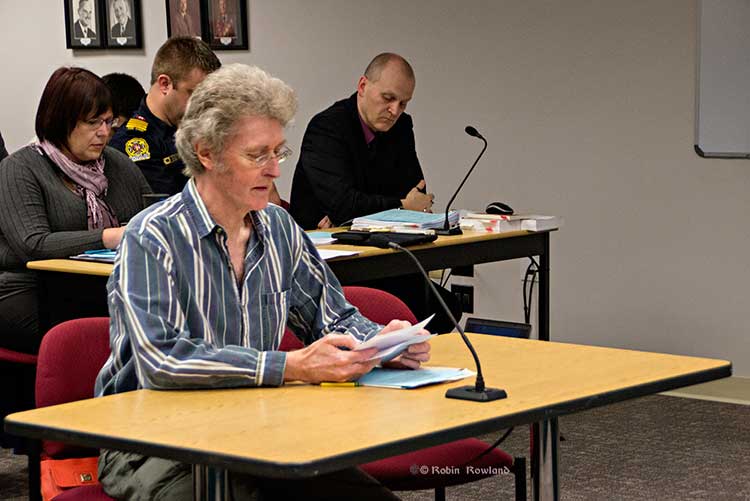A pile of slash at a quarry site for the Pacific Trail Pipeline near the Little Wedeene River. (Robin Rowland)
Category: Pacific Trail Pipeline
Bish Forest Service Road reopens to the public on March 1, 2015
The Bish Forest Service Road will reopen to the public on March 1, 2015. With the upgrades created by the Chevron-led Kitimat LNG project, the single lane logging rough logging is now a high quality gravel “resource road.”
The first 12 kilometres of the road will be open “to provide public access to connecting roads, recreational areas and natural hiking trails,” Chevron says.
“In terms of Kitimat specifically we’ve completed a number of key projects,” said David Molinski, Chevron’s lead for Regulatory and External Affairs. “We’ve made the upgrades to the Forest Service Road, and the Early Works we’ve been doing on site at the Bish Cove site.

“So we’ve been for the past couple of years putting a lot of effort on advancing that part of the project. We’ve completed the key elements of the Forest Service Road upgrades over the past four years,” Molinksi said, “When we got there it was essentially a single track logging road and it was very difficult to access the Bish Cove site. So we wanted to make sure we had a road that would help support the project. That means having an all weather access all year round. That’s a very substantial development.
“It’s a public road, it’s always has been a public road, in fact it’s owned by the Crown.
“It’s time now for us to reopen that road. We had it closed for safety reasons. We wanted to make sure we completed the work on the road. There was blasting, moving rock, breaking down rock, stabilizing slopes.
“We had to make sure we could that work done in a safe way. Now that’s done, we’ve completed the road upgrades and we’re very happy to reopen it to the public. We look at it as being a long term legacy for the community.

“The road is available for people in the community to use. There’s a number of recreation sites people in the community have used for many generations. So we’re pleased we can turn that road back into being publicly available and they can use it safely so they can get access to the areas they love around this community.”
In 2015, Chevron says, some work may continue on the road and “may include power line installation, paving and other construction activities.” There is also a need for the road to “stabilize” Molinksi said. “We’ll come back down the road and make a decision about what the right timing is to cap that road. Right now we don’t have a specific schedule It’s good for the road to stabilize and settle over the next couple of seasonal cycles.”
The decision about the future of the road will depend on the uncertain investment climate, due to the downturn in the energy industry.
In a panel at the open house on Feb. 24, Chevron said that projects like Kitimat LNG “are significant, very large and extremely complex with multiple moving parts that must all come together through hard work and perseverance in order to be successful.”

Chevron will continue to make a capital investment on the Kitimat side of the project but “the pace of field work in Kitimat at the LNG Plant will be decreasing as we focus capital spending on other aspects of the project.
For 2015, Chevron will concentrate on exploration in northeast British Columbia, Molinksi said, “That’s where the Liard Basin and the Horn River Basin are located and that’s where we’re developing the natural gas, substantial natural gas resources to support this project… This year we’re going to focus on getting additional data on the natural gas that we have a number of rigs that are running right now. We’re going to be drilling wells over 2015 and make sure we have a good understanding of those wells that are going to be supplying gas to this project. We have to know as much about that resource as this site here.”
“As a result there will be a decrease in site preparation work associated with the Kitimat LNG project and the Pacific Trails Pipeline during 2015,” the Chevron panel said.
Moricetown band joins Pacific Trail Partnership, Kitimat LNG now has all First Nation councils on board
Chevron, the lead corporation in the Kitimat LNG project announced on January 23 that the Moricetown Indian Band had agreed to join the First Nations Limited Partnership, in effect, approving the Pacific Trail Pipeline that would take natural gas to the project in Kitimat.
Here is the news release from all parties involved.
Vancouver, British Columbia, January 23, 2015 – The First Nations Limited Partnership (FNLP) today announced that Moricetown Indian Band (Moricetown) has joined the FNLP. The FNLP is a commercial partnership that, with the addition of Moricetown, now includes all of the 16 First Nations whose traditional territory is located along the proposed 480 kilometre Pacific Trail Pipeline (PTP) route from Summit Lake to Kitimat, B.C.
“The decision of the Moricetown First Nation Band Council to join the First Nations Limited Partnership is one that we warmly welcome,” said the Honourable Bob Rae, Chairman of FNLP.
“It means all 16 First Nations along the proposed Pacific Trail Pipeline route are partners in a unique approach that combines environmental stewardship, extensive job, procurement, and other economic benefits, and direct financial transfers on a regular basis to each First Nations community.”
The FNLP is without precedent in the Canadian energy industry and the Pacific Trail Pipeline is the only proposed natural gas pipeline for a liquefied natural gas (LNG) facility in B.C. with such a benefits agreement. The proposed PTP and Kitimat LNG Facility projects are owned by Chevron and Apache through a 50/50 joint venture and are operated by Chevron.
“This agreement is unparalleled in balancing strong economic growth measures with preserving our cultural heritage and the environment. There is, quite simply, no other deal that comes close to what we’ve been able to achieve in this partnership,” said Chief Dan George of Ts’il Kaz Koh (Burns Lake).
The commercial partnership ensures that FNLP Nations receive immediate and long-term benefits from the PTP project. These include up to $550 million in direct financial benefits over the life of the PTP project, including a recent enhanced benefit of $10 million a year operating life of the PTP project from the Province of British Columbia. The FNLP Nations also receive substantial economic development, skills training, employment and contracting benefits from PTP under the terms of the agreement.
“Chevron Canada wishes to commend all parties for creating a partnership between industry and First Nations based on mutual respect, trust and economic self-determination. We welcome Moricetown as the 16th member of the FNLP, and look forward to building the Pacific Trail Pipeline with First Nations in a manner that places the highest priority on protecting people and the environment,” said Jeff Lehrmann, President, Chevron Canada Limited.
Measures that reflect environmental protection, vitality of traditional cultural values, protection of aboriginal rights and title, economic self-determination and a sustainable future for First Nations are also part of the FNLP agreement. Members of the FNLP have already received significant benefits to date from the agreement, including $17 million in financial payments.
“We have already seen over 1,600 First Nations members receive skills training through the PTP Aboriginal Skills to Employment Partnership, better known as PTP ASEP. Over 900 of these trainees have found jobs,” said Chief Karen Ogen of the Wet’suwet’en First Nation.
First Nations employment currently accounts for 54 per cent of all early works construction workforce hours to date on the Pacific Trail Pipeline. To date, FNLP members have also been awarded over $245 million in PTP construction contracts, and over 65 per cent of construction contract expenditures have been made to member First Nation businesses.
The agreement also facilitates joint ventures between FNLP and companies engaged in the PTP Project. As such, the FNLP Nations not only have a clear financial interest in the pipeline construction but, just as importantly, also have a strong voice in ensuring the preservation of environmental and cultural integrity.
“The FNLP is an innovative model for how industry and First Nations can cooperate effectively with respect to major economic development projects,” said the Honourable Bob Rae.
About First Nations (PTP) Group Limited Partnership (FNLP)The First Nations (PTP) Group Limited Partnership (FNLP) is a limited partnership of 16 First Nations whose traditional territories are located along the transportation corridor between Summit Lake and Kitimat, British Columbia.
FNLP was formed to secure significant, reliable and long-term economic benefits for its limited partners from the proposed PTP Project.
FNLP member Nations are:
* Haisla Nation
* Kitselas First Nation
* Lax Kw’alaams Band
* Lheidleh T’eneh First Nation
* McLeod Lake Indian Band
* Metlakatla First Nation
* Moricetown Indian Band
* Nadleh Whut’en First Nation
* Nak’azdli Band
* Nee Tahi Buhn Indian Band
* Saik’uz First Nation
* Skin Tyee First Nation
* Stellat’en First Nation
* Ts’il Kaz Koh First Nation (Burns Lake Indian Band)
* West Moberly First Nations
* Wet’suwet’en First Nation
About PTP and the Pacific Trail Pipelines Limited PartnershipThe proposed 480-kilometre Pacific Trail Pipeline Project is jointly owned by Chevron Canada Limited (Chevron) and Apache Canada Ltd. (Apache) through the Pacific Trail Pipelines Limited Partnership (PTPLP). The PTP is intended to deliver natural gas from Summit Lake
B.C. to the proposed Kitimat LNG facility on B.C.’s north coast. The Pacific Trail Pipelines Limited Partnership (PTPLP) acquired the project in February 2011 from Pacific Northern Gas.
The fact that the Moricetown Band had held out for so long was seen as one of several factors that was holding up a Final Investment Decision by Chevron and its soon to be new partner, Australia’s Woodside Pretroleum, which is currently finalizing a deal to buy Apache’s stake in the project. Chevron vice chairman, George Kirkland was asked about it during an investor conference call in August, 2014 At the time, Kirkland hinted at the potential problems with the Pacific Trails Pipeline, where there is still a dispute with members of the Wet’suwet’en First Nation. “We’re going to focus on the pipeline and the end of the pipeline corridor. That’s important and we’re putting some money into that to finalize the pipeline routing, get all our clearances and then we’ve got work going on.”
The Unist’ot’en Camp group which opposes energy development in the traditional territory of that House has not yet commented on the announcement. However, earlier Friday at a protest in Winnipeg, Freda Huson, Spokesperson for the Unist’ot’en People and Hereditary Chief Toghestiy of the Likhts´amisyu Clan, issued this statement.
¨The Hereditary Chiefs of the Wet´suwet´en People will stop all attempts from Pipeline Companies, Colonial Governments, and their sell-out employees from bringing Tar Sands Bitumen or Fracked Gas onto our lands. We have ancestral integrity which guides us and will help us ensure that we make the right decisions to protect our lands for all of our unborn generations. We will hold ALL those accountable for attempting to enable destructive agendas to take hold on our sacred lands. We will use our traditional governing systems, the colonial courts, grassroots Indigenous Peoples, and our media savy to make everyone associated with Pipelines, Tar Sands, and Fracking activity from affecting our unceded lands. We are armed with our indomitable spirit and 2 Supreme Court of Canada decisions and will use them against any more aggressors on our unceded lands. Consider this a warning for attempting to trespass on our homelands. We have defended our lands for countless generations and we will stand up like our ancestors have to ensure that we never are viewed as weak in the eyes of our ancestors or children.
Apache still looking for buyer for Kitimat LNG stake
Apache Corp is still looking for a buyer for its stake in the Kitimat LNG project, company CEO Steven Farris told investors Thursday as the company reported its third quarter results. Farris gave no details, just telling an investor conference call, that as he reported during the second quarter call, that company intends to “completely exit” both the Kitimat LNG project and the Wheatstone LNG project in Australia.
All Farris would say is, “We have lots of people working on the projects to do just that.”
At that same time, Apache is still spending money on the Kitimat project. The quarterly report says that Apache spent $151 million on the project in the third quarter, and a total of $498 million so far this year. That includes an equity investment in the Pacific Trail Pipelines $15 million in the third quarter and $44 million so far this year.
Chevron, Apache’s partner continues to work on the Kitimat project.
Controlling land and pipelines key to Haisla LNG future NEB filing says
The Haisla Nation’s plan for entering the LNG business is based on the idea that “it is anticipated that the Haisla Projects will be developed using a business model based on controlling two components of the value chain: land and pipeline capacity” according to its application to the National Energy Board for a natural gas export licence.
Cedar LNG Development Ltd., owned by the Haisla Nation, filed three requests for export licences with the NEB on August 28, under the names Cedar 1 LNG, Cedar 2 LNG and Cedar 3 LNG. Another name used in the application is the “Haisla Projects.”
The 25-year export licence request is standard in the LNG business; it allows export of natural gas in excess of projected North American requirements. Thus like the NEB hearings for the Kitimat LNG and LNG Canada projects it is not what is called a “facility” licence which is what Enbridge Northern Gateway requested.
The project anticipates six “jetties” that would load LNG into either barges or ships at three points along Douglas Channel, one where the present and financially troubled BC LNG/Douglas Channel Partners project would be.
A second would be beside the BC LNG project, which may refer to the Triton project proposed by Pacific Northern Gas parent company Altagas.
Both are on land now owned by the Haisla Nation in “fee simple” land ownership under Canadian law.

The other four would be on land surrounding the current Chevron-led Kitimat LNG project along Douglas Channel and in the mountains overlooking Bish Cove which the Haisla have leased.

The move last week and the revelation of the Haisla’s plans for the land are a cumulation of Haisla Nation Chief Counsellor Ellis Ross’s idea of restoring more of the First Nation’s traditional territory by buying or leasing the land using standard Canadian land law and at the same time getting around some of the more restrictive provisions of the Indian Act that apply to reserve land.
Just how the Haisla will go into the pipeline business is not as clear as the First Nation’s acquisition of the land. The application says:
The pipeline capacity required to transport sourced LNG to the Haisla Projects will include a mix of new and existing pipeline and infrastructure. The Haisla are in the advanced stages of negotiating and drafting definitive agreements with the major gas producers and pipeline transmission companies located in the vicinity with respect to securing pipeline capacity. It is expected that the Haisla Projects will rely on the Haisla’s business partners or customers to source gas from their own reserves and the market.
With the Haisla basing their business strategy on land and pipelines, the First Nation’s strategy is looking for flexibility in what is a volatile and uncertain market for LNG.
The application says the Haisla “are currently in advanced stage discussions and negotiations with a number of investors, gas producers, LNG purchasers, pipeline transmission companies, technology providers and shippers. As such, the particular business models have yet to be finalized. However, it is anticipated that between the various Haisla Projects, multiple export arrangements may be utilized.”
As part of the idea of flexibility, the actual LNG infrastructure will be constructed and operated with potential partners. That is why there are three separate applications so that each “application will represent a separate project with independent commercial dealings with investors, gas producers, LNG purchasers, pipeline transmission companies, technology providers and shippers.”
The Haisla say that they are “working with a number of entities to develop business structures and partnerships to provide transaction flexibility, adequate financing, modern technology, local knowledge, and marketing expertise specific to Asian targets. The separate projects will accommodate expected production and demand and will also allow for a number of midlevel organizations to be involved with the various projects as well as traditional major gas producers and LNG purchasers.”
The Haisla are working with the Norwegian Golar LNG which had been involved in the stalled BC LNG project, using a Golar LNG’s vessels and technology, using a new design that is now being built in Singapore by Keppel Shipyard.
Golar LNG uses PRICO LNG process technology developed by Black & Veatch, (Wikipedia entry) “which is reliable, flexible and offers simplified operation and reduced equipment count.”
The filing says the project will “be developed using either barge-based or converted Moss-style FLNG vessels. The terminals will consist of vessel-based liquefaction and processing facilities, vessel-based storage tanks, and facilities to support ship berthing and cargo loading”
The jetties to be used for the Haisla Projects may be either individual FLNG vessels or “double stacked”, meaning that the FLNG vessels are moored side-by-side at a single jetty. The Haisla have conducted various jetty design work and site /evaluation studies with Moffat and Nichol.
The Haisla Projects anticipate that the construction will be in 2017 to 2020, “subject to receiving all necessary permits and approvals” and is expected to continue for a term of up to twenty five years. There is one warning, “The timelines of the Haisla Projects will also depend on the contracts and relationships between the Applicant and its partners.”
The filing goes on to say:
Haisla Nation Council and its Economic Development Committee are committed to furthering economic development for the Haisla. The Haisla’s business philosophy is to advance commercially successful initiatives and to promote environmentally responsible and sustainable development, while minimizing impacts on land and water resources, partnering with First Nations and non-First Nations persons, working with joint venture business partners, and promoting and facilitating long-term development opportunities.
The Haisla Applications will allow the Haisla to be directly involved as participants in Canada’s LNG industry, rather than having only royalty or indirect interests. The Kitimat LNG and LNG Canada projects, and the associated Pacific Trails Pipeline and Coastal Gas Link Pipeline, have increased economic opportunities in the region and the Haisla are very supportive of these projects locating within the traditional territory of the Haisla. The support of the Haisla for these two projects reflects a critical evolution of the Haisla’s economic and social objectives.
You can see the filing on the NEB projects page at http://www.neb-one.gc.ca/clf-nsi/rthnb/pplctnsbfrthnb/lngxprtlcncpplctns/lngxprtlcncpplctns-eng.html


Chevron sticks with Kitimat but no final investment decision until customers sign
Chevron is sticking with the Kitimat LNG project but won’t make a Final Investment Decision until it has signed sales and purchase agreements for between 60 and 70 per cent of the natural gas, Chevron’s vice-chairman and executive vice-president of upstream operations, George Kirkland told investment analysts in a conference call Friday.
Kirkland said that decision will happen “irrespective of what happens with Apache,” which has decided to completely exit the project.
 “We need to get partnership resolved and Apache has to move through the issues s and we need to get a new partner in. That needs to happen. That’s quite obvious,” Kirkland added.
“We need to get partnership resolved and Apache has to move through the issues s and we need to get a new partner in. That needs to happen. That’s quite obvious,” Kirkland added.
Other factors, Kirkland told the call, are final test results from the Liard and Horn River natural gas play in northeast British Columbia and finalization of the “pipeline corridor.”
Kitimat-Liard-Horn package
Although the residents of Kitimat are focused on the LNG terminal at Bish Cove, remarks both by Kirkland today and by Apache CEO Steve Farris Thursday, it appears that energy industry views Kitimat LNG as part of a “package” (a term used by both) that includes the Liard and Horn River gas fields and the connecting Pacific Trails Pipeline.
Kirkland also said Chevron has no interest in any further investment beyond the 50 per cent it already holds. “We have 50 per cent of the interest in Kitimat-Liard-Horn River assets. That’s right in the middle of the sweet spot where we like to be where we’re committing people to run the projects and operations. We don’t want more than 50 per cent but we do have available some small amount of working interest that we would provide to a LNG buyer.
“There’s always been a plan for us and Apache to have some working interest that could be sold down to buyers, so they would be part of the development and they would be in the value chain. That has not changed.”
Kitimat LNG’s rival project LNG Canada, run by Shell, has buyer partners in KoGas, Mitsubishi and PetroChina.

Final Investment Decision
One analyst asked Kirkland if the Final Investment Decision would come at the end of 2014, as previously announced, or in 2015. Instead, Kirkland said, “We will reach FID shortly after having 60 to 70 per cent gas committed to an SPA- a sales and purchase agreement. That is the critical decision maker and for both timing and the investment decision, irrespective of what happens with Apache. We’re driven, once again, by having a sales contract or sales contracts that gives us 60 to 70 per cent of the gas committed at an economic price.”
On the Kitimat terminal, Kirkland said, “We’ve got work going on, FEED [Front End Engineering and Design] work on the plant itself.
“We have to understand cost and schedule on that plant… We’re not spending huge money but it is a lot of money in terms of hundreds of millions of dollars. Now that is critical for us to have all that so we can deal knowledgeably with buyers. We have to understand cost. We have to understand resource, so we can deal with the particulars of pricing.
“We are not going to do a project unless it’s economic. We’ve always told you we’re not going to build that project unless we have 60 per cent of the gas sold. If you understand the project it makes sense.”
“I am not concerned if Apache leaves,” Kirkland said. “I think we could easily step in and be the operator of the upstream. I am confident there. Apache has been very good to work with in the early stages of the assessment of Liard.
“I think we’re in good shape but we need clarity, we need to get closure on the partnership and as I mentioned we have to do the work where we deal with buyers and understand costs and understand economics. We are very value driven, we are not going to go FID until we understand the economics of that sale.”
Confident on assets
Kirkland said that the company is confident about the assets in the Liard and Horn River regions but is waiting for final results from some test wells in the Liard.
“We can check off our confidence level on the Horn River. Resources are already high. We’ve already done that appraisal. So the focus on the resource sector is on the Liard, with some appraisal there and getting some production work. The wells where we need to get some production data will be complete by the end of the year. So that’s a really important step forward.”
Kirkland also hinted at the potential problems with the Pacific Trails Pipeline, where there is still a dispute with the Wet’suwet’en First Nation. “We’re going to focus on the pipeline and the end of the pipeline corridor. That’s important and we’re putting some money into that to finalize the pipeline routing, get all our clearances and then we’ve got work going on.”

Overall Kirkland was enthusiastic about other liquified natural gas projects in Australia and elsewhere in the world. Chevron Corporation reported earnings of $5.7 billion for the second quarter 2014, compared with $5.4 billion in the 2013 second quarter. Sales and other operating revenues in the second quarter 2014 were $56 billion, compared to $55 billion in the year-ago period.
Company CEO John Watson said a news release, “In Australia, our Gorgon and Wheatstone LNG projects continue to reach important interim milestones. Gorgon remains on track for expected start-up in mid-2015. We are also advancing the development of our liquids-rich, unconventional properties in the United States, Canada and Argentina.”
Editorial: (II) Kitimat Council in chaos

The District of Kitimat Council is in chaos. We’re not referring to Monday’s chaotic meeting where often it was hard to figure out what Councillors were saying and where they were going.
We are referring to “Chaos” as it is defined in physics, “sensitive dependence on initial conditions,” known to most people as the “butterfly effect” (the exaggerated notion that a butterfly flapping its wings in one place could cause a storm in another place). Or we could suggest that Kitimat Council has a critical case of bad karma that is now coming back to haunt them.
How can you trust a council that doesn’t understand and follow its own motions?
District Council claims it is neutral on the Enbridge Northern Gateway project. That is wrong.
District Council decided, in violation of its own resolutions, to do absolutely nothing about the Northern Gateway Project until they have to. Doing nothing is not neutrality. Doing nothing is a default notion that actually tilts council in favour of the Enbridge Northern Gateway project. Doing nothing has meant that Council has become incapable of dealing with Gateway related issues within its own jurisdiction because they have no idea of what is going on.
A tale of two motions
So what were the initial conditions? As Peter Ponter pointed out in his presentation to Council Monday night, the original motion on neutrality called on Council to take an active part in the Joint Review proceedings.
As reported in the Kitimat Daily at the time, the motion from Councillor Rob Goffinet read:
”I move that the Mayor and Council of District of Kitimat go on record neither opposing nor supporting the Enbridge Pipeline Super Tanker Proposal and that we wish to, as a Mayor and Council, with our community, take part in the 1-2 year environmental assessment process and the Joint Review Panel to learn and understand whether this will be a beneficial project to Kitimat, the Northwest and British Columbia.
That motion was carried unanimously.
So then what happened? Nothing. The District of Kitimat did register as a government participant in the proceedings but did nothing to actually actively participate “to learn and understand whether this will be beneficial project to Kitimat….”
With the 2011 election over, the new council, sitting for the first time in 2012, was asked to reaffirm its position. At that time, Phil Germuth presented a motion that council survey the residents of Kitimat to find out what their position was on the Northern Gateway project. Our report here and Kitimat Daily’s report here.
At the time Councillor Mario Feldhoff said:
“The perfect time for the community to indicate whether they support is to reflect upon the JRP report. Do we agree with their submissions? Otherwise, our emotions are getting ahead of us and we may be perceive as being late in the game but, we may have, from my perspective, informed comment from the citizenry after they have had a chance to read a report from the JRP would be preferable in my opinion, in opposed to getting a sense of how people feel about things right now.”
So, in fact, there was not one neutrality motion as Council now maintains.
There were two separate motions, on two separate aspects of neutrality. The first called for council to remain neutral but to participate in the Joint Review Panel. The second called for council to survey the community on their feelings after the completion of the JRP.
The two motions did not, repeat not, cancel each other out. But that was, in effect, what happened. The council seems to have decided that Feldhoff’s comment was actually a motion, and that after that January 2012 meeting, they should do absolutely nothing but wait until the Joint Review Process was complete.
Every time after January 2012, when council was asked about anything, they said we are waiting for the Joint Review Process to be complete, even though council had unanimously passed a motion saying it would take part in the JRP. That is proof of Kitimat Council’s incompetence.
As we pointed in May 2012, after the introduction of the Omnibus bills, neutrality has never meant sitting on one’s ass and doing nothing. Neutral nations have always vigorously looked out for their own interests.
We will repeat that in the long history of regulatory hearings, public inquiries and even coroners inquests there have always been a role for neutral parties, represented by competent and properly instructed counsel, who vigorously look out for their client’s interests, without taking an advocacy position on a matter before the tribunal. The District of Kitimat could have, in fact, should have, actively participated and where necessary in the Joint Review and have its representatives ask tough questions of every side on all matters relevant to the District of Kitimat.
Participation didn’t happen, and, unfortunately, that is now all water under the Kitimat River Bridge.
A gift of prophecy

The bigger problem is that a majority on Kitimat council believes that it has the gift of prophecy, naively believing that the Joint Review Panel understands all mysteries and all knowledge. A majority of members on Kitimat council have blind faith, believing that the JRP can safely move pipelines across mountains.
With its gift of prophecy, Kitimat Council believes that all is right with the Joint Review Panel, that its 209 recommendations are gospel and thus council approves a vote question not about the Northern Gateway project but the Joint Review.
Faith is the operative word, for apart from dropping into listen from time to time, council did not participate in the proceedings in any way, and thus did not experience the many flaws in the Joint Review process that led some people to say as early as the middle of 2012 that the JRP had no credibility.
We’re already seeing the flaws in the blind faith in the JRP. As this site pointed out, the costs of the Kalamazoo cleanup now exceed the amount of money the JRP conditions call on Enbridge to set aside in case of a spill. A report by federal scientists show the Joint Review Panel erred in accepting Enbridge’s laboratory evidence that bitumen doesn’t sink.
There are already court challenges to the Joint Review Panel. (Update. A media count as of January 23 says there are now 10 court challenges to the JRP)
Most important for Kitimat, a challenge filed by the Haisla Nation which, among the many flaws it finds with the JRP report, says the JRP improperly concluded that a large spill is unlikely either from the pipeline itself, the terminal facilities or the oil tankers tasked with navigating B.C.’s coastal waters.
It doesn’t do much for the already strained relationship between the District of Kitimat and the Haisla Nation that Council continues its uncritical support of the JRP while the Haisla are challenging it in court. That the Haisla motion to the Federal Court of Appeal includes challenges to the procedural unfairness of the JRP proceedings.
The Gitxaala First Nation says Joint Review Panel ignored issues surrounding aboriginal rights and title.
A coalition of environmental groups have told the federal court there was not enough evidence before the JRP to support its conclusion that the Northern Gateway pipeline would not have significant adverse effects on the environment; one key part of the suit is the fact that the JRP refused to consider the federal humpback strategy for Douglas Channel.
Although it is unlikely that the courts will throw out the Joint Review findings before the April vote, it might just happen. At that point, a plebiscite question based on the JRP would look pretty silly.
Who runs the Kitimat River?
We now come to the long term consequences of a do nothing council. We have to ask if the District of Kitimat Council will become lame ducks, at least in some part of town, because they have stood by and, in their misplaced faith in the National Energy Board, ceded the right to decide what happens in Kitimat to the NEB?
According to a report in the Toronto Star, using the new rules under the omnibus bills, this week the National Energy Board approved expansion of the Enbridge Line 7 pipeline in southern Ontario, without a hearing and without notifying Hamilton, the municipality involved (the pipeline actually goes through Hamilton) because the municipality was not “affected in any way” by the project. Since the media got on to the story, Enbridge has kindly said to Hamilton “we have heard and understood it and assured them directly that we will include them in all future consultation and activity on this project.”
There was another decision by the National Energy Board in December, when it agreed with DFO that it would have jurisdiction on fish habitat, if there are pipelines along water bodies such as the Kitimat River. DFO has since clarified their position, which means we’re not going to see the absurd vision of NEB officials checking fishing licences in Radley Park.
There is already one pipeline along the west bank of the Kitimat River, Pacific Northern Gas. If the LNG projects go ahead, as well as more molecule traffic on the PNG pipeline there will be the Coastal Gas Link serving Shell and the Pacific Trails Pipeline serving Chevron and Apache. If it goes ahead, the Northern Gateway Pipeline will mean four pipelines along the west bank of the Kitimat River.
Four pipelines along the banks of the Kitimat River all under the benign eye of the National Energy Board in Calgary since they have “expertise” on pipelines and water courses.
The NEB has shown recently it doesn’t have much respect for municipalities. While the actual regulations under the DFO-NEB deal are likely to be unclear for some time, we know that what the NEB’s mandate is, to promote the oil and gas industry in this country, not to protect rivers and streams. So if the people of Kitimat, especially those who fish the Kitimat River or work in the Service Centre are in the way of what NEB bureaucrats in Calgary decide is best for us and those three, maybe four, pipelines, well too bad, eh? The NEB has the mandate to act in the national and public interest, not the residents of Kitimat.
Kitimat Council with its blind faith in the National Energy Board may very likely be a case of be careful what you wish for, sitting uselessly in the chambers at Northwest Community College while the NEB in Calgary carves up the District’s jurisdiction and does what it thinks is best for the oil patch.
Thus the Council deliberations become a sounding brass or a tinkling cymbal, meaning nothing.
Chevron advertises for Houston-based Kitimat plant logistics manager
Chevron, which recently took over management of the Kitimat LNG project is advertising for a Houston, Texas, based logistics manager for the project.
The ad gives (in part) this job description:
Chevron is accepting online applications for the position of Kitimat Plant Logistics Manager located in Houston, TX through February 19, 2013 at 11:59 p.m. (Eastern Standard Time).
The Kitimat LNG project is located in Western Canada and includes 1) construction of the 2 x 5.5 MTPA Kitimat LNG Plant and 2) the Pacific Trails Pipeline.
Responsibilities for this position may include but are not limited to:
Responsibility for overseeing and managing the entire plant logistics program including module, equipment and bulk cargo logistics throughout the overall supply chain. Development of the necessary organizational capability within the Kitimat team, Engineering, Procurement & Construction (EPC) Re / Engineering, Procurement and Construction (Management) (EPCM) Contractor organization, and selected logistics contractors’ organizations
Assist in the development of contract ITB templates and scopes of work for project logistics contracts for (a) Heavy module marine/road transport and (b) General cargo transport from worldwide locations to module yards and Kitimat, freight forwarding services, and in-country transport, including development of criteria to evaluate bids.
Oversee the selected logistics contractors’ performance of project logistics, focusing primarily on the movement of prefabricated modules from multiple locations to ports near Kitimat.
Chevron takes over Kitimat LNG operations from Apache, EOG and Encana
 Apache has a new partner in the Kitimat LNG project, Chevron Canada Ltd and, in effect, Chevron is taking over the project from Apache who has been unable to find customers for the liquified natural gas project in Asia.
Apache has a new partner in the Kitimat LNG project, Chevron Canada Ltd and, in effect, Chevron is taking over the project from Apache who has been unable to find customers for the liquified natural gas project in Asia.
A news release from Apache announced “a broad agreement with Chevron Canada Limited to build and operate the Kitimat LNG project.”
Chevron Canada and Apache Canada each will become a 50 per cent owner of the Kitimat LNG plant, the Pacific Trail Pipeline and 644,000 gross undeveloped acres in the Horn River and Liard basins. Chevron Canada will operate the LNG plant, which will be located on the northern British Columbia coast, and the pipeline. Apache will continue to develop shale gas resources at the Liard and Horn River basins in north eastern BC.
Encana and EOG Resources — currently 30 percent non-operating partners in Kitimat LNG and Pacific Trail Pipeline — will sell their interests to Chevron and exit the venture. As part of the transaction with Chevron, Apache will increase its ownership of the plant and pipeline to 50 percent from 40 percent.
G. Steven Farris, Apache’s chairman and chief executive officer said in the company news release, “This agreement is a milestone for two principal reasons: Chevron is the premier LNG developer in the world today with longstanding relationships in key Asian markets, and the new structure will enable Apache to unlock the tremendous potential at Liard, one of the most prolific shale gas basins in North America.” “With experience developing LNG projects, marketing expertise and financial wherewithal, Chevron is the preferred coventurer to join Kitimat LNG,” Farris said. “Apache has a proven record in finding and developing shale gas resources in Canada and is the logical operator for the upstream elements of the joint venture.”
In its news release, Chevron quoted vice chairman George Kirkland as saying: “The Kitimat LNG development is an attractive opportunity that is aligned with existing strategies and will drive additional long-term production growth and shareholder returns.”
“This investment grows our global LNG portfolio and builds upon our LNG construction, operations and marketing capabilities. It is ideally situated to meet rapidly growing demand for reliable, secure, and cleaner-burning fuels in Asia, which are projected to approximately double from current levels by 2025.”
The two-train (stage) Kitimat LNG Project is still working through the Front-End Engineering and Design (FEED) phase. Construction has continued at the Bish Cove site throughout the summer but has slowed down to the uncertainty over the future of the project and some environmental problems.
Current plans call for two liquefaction trains, each with expected capacity of 5 million tons of LNG per annum (about 750 million cubic feet of gas per day). Kitimat has received all significant environmental approvals and a 20-year export license from the Canadian federal government.
The 290-mile (463-km) Pacific Trail Pipeline is planned to provide a direct connection between the Spectra Energy Transmission pipeline system and the Kitimat LNG terminal.
While the Apache release says: “The project has strong support from many of the First Nations along the route,” there is no support at this moment from the Wet’suwet’en, in the area from Burns Lake through Smithers to the mountains, because some houses are strongly opposed to the pipeline on their traditional territory.
In the Apache news release, Farris says: “”We want to thank and acknowledge EOG and Encana for their contribution to the development of the Kitimat project. We appreciate the hard work of many employees and contractors to advance the project to this stage and the strong support the plant and pipeline projects have received from local communities, provincial and federal officials and the Haisla and other First Nations.
“Construction of the plant and pipeline will have a significant economic impact, and the operational phase will provide opportunities for employment as well as royalties and tax revenues for the Federal, Provincial and local governments for many years,” he said. “Chevron and Apache will continue to develop this project in a safe and environmentally responsible manner.”
As the news releases point out Chevron is a major player in Australia’s LNG projects, considered by many to be Canada’s rival in finding market for natural gas in Asia. Chevron is the operator and led marketing efforts at Wheatstone, a two-train plant with capacity of 8.9 million tons of LNG a year that is expected to commence operations in 2016. Chevron also operates the Gorgon LNG project in Australia and LNG Angola.
Much of the media attention is also on the deal for the natural resources northeastern BC, with, Chevron Canada acquiring approximately 110,000 net acres in the established Horn River Basin from Encana, EOG and Apache, and approximately 212,000 net acres in the Liard Basin from Apache. Chevron Canada Limited and Apache will each hold a 50 percent interest and Apache will operate these two natural gas resource developments.
In its news release, Encana concentrates on the natural gas deal, quoting Randy Eresman, Encana’s President & CEO, “This investment by Chevron, a multinational LNG player, represents a key step in the development of LNG export from Western Canada. Our main goal since we first acquired an interest in Kitimat LNG almost two years ago was to help ensure the progression of this project towards its development. While we are no longer a direct participant in this project, we continue to support LNG export as vital to diversifying markets for North American natural gas.”
The company goes on to say that: “The sale of Encana’s interest in the proposed Kitimat LNG export facility is consistent with the company choosing to focus on its core business. In addition, this transaction reduces Encana’s future capital commitments. The proceeds from this transaction will help to strengthen the balance sheet and provide further financial flexibility to fund capital programs and develop key and emerging resource plays.”
The Financial Post points out that “the Chevron deal leaves most of the LNG projects in the hands of foreign companies, which have competing interests in LNG projects across the world.” That means that the Haisla Nation, with its partnership with the BC LNG project, is one of the few Canadian players left in the LNG scramble.
TransCanada plans rugged over-mountain route for gas pipeline to Kitimat

TransCanada plans a rugged over-mountain route for its proposed Coastal Gaslink pipeline to the Shell Canada liquified natural gas project in Kitimat, BC, company officials said Monday, Oct. 15, 2012, in two presentations, one to District of Kitimat Council and a second at a community town hall briefing.
The pipeline would initially carry 1.7 billion cubic feet of natural gas per day from the Montney Formation region of northeastern British Columbia along a 48 inch (1.2 metre) diameter pipe over 700 kilometres from Groundbirch, near Dawson Creek, to Kitimat, site of the proposed Shell Canada LNG Canada project.
Rick Gateman, President of Coastal GasLink Project, a wholly owned TransCanada subsidiary told council that the project is now at a “conceptual route” stage because TransCanada can’t proceed to actual planning until it has done more detailed survey work and community consultations.
At the same council meeting, documents from Shell Canada notified the District that it has formally applied to the National Energy Board for an export licence for the natural gas.

Gateman told council that since the pipeline itself will be completely within the province of British Columbia, it comes under the jurisdiction of the British Columbia Environmental Assessment process and the BC Oil and Gas Commission and that the NEB will not be involved in approving the pipeline itself.
At first, the Coastal Gas Link pipeline would be connected to the existing Nova Gas Transmission system now used (and being expanded) in northeastern British Columbia.
From Vanderhoof, BC to west of Burns Lake, the Coastal GasLink pipeline would be somewhat adjacent to existing pipelines and the route of the proposed Enbridge Northern Gateway bitumen pipeline and the proposed Pacific Trails natural gas pipeline.
Somewhat south of Houston, however, the pipeline takes a different route from the either the Northern Gateway or Pacific Trails Pipeline, going southwest, avoiding the controversial Mount Nimbus route.
Howard Backus, an engineering manager with TransCanada told council that the route changes so that Coastal GasLink can avoid “congestion” in the rugged mountain region.
Backus said that the Pacific Trails Pipeline for Apache and its partners in the Kitimat LNG project “is skirting” Nimbus while Enbridge plans to tunnel through the mountain. That tunnel is one of the most controversial aspects to the Northern Gateway project. The local environmental group Douglas Channel Watch has repeatedly warned of the dangers of avalanche and geological instability in the area where the Northern Gateway pipeline emerges from the tunnel. Enbridge has challenged Douglas Channel Watch’s conclusions in papers filed with the Northern Gateway Joint Review panel.
Under TransCanada’s conceptual route, the pipeline heads southwest and then climbs into the mountains, crossing what Backus calls “a saddle” (not a pass) near the headwaters of the Kitimat River. The pipeline then comes down paralleling Hircsh Creek, emerging close to town, crossing the Kitimat River and terminating at the old Methanex plant where Shell plans its liquified natural gas plant. (That means that if the conceptual plans go ahead, the TransCanada pipeline would climb into the mountains, while Pacific Trails finds a way around and Enbridge tunnels).
Backus told council that going north “created more issues,” but did not elaborate.
Backus assured people at the town hall that energy companies have a lot of experience in building pipelines in mountainous areas, including the Andes in South America.
Asked by a local businessman at the town hall if it was possible to build a road along the route of the pipeline, Backus said the mountain areas would be too steep. Any pipeline maintenance would have to be done by tracked vehicle, he said.
Gateman told council that the pipeline would be buried along its entire route. If Shell increases the capacity of its LNG facility in Kitimat, the Coastal Gaslink pipeline could increase to 3.4 billion cubic feet a day or perhaps even more. For the initial capacity, the company will have one compressor station at the eastern end of the line. If capacity increases or if the route requires it, there could be as many as five additional compressor stations. (TransCanada’s long term planning is based on the idea that Shell will soon be adding natural gas from the rich Horn River Formation also in northeastern BC to the Kitimat export terminal.)
TransCanada will begin its field work, including route and environmental planning and “community engagement” in 2013 and file for regulatory approval in 2014. Once the project is approved, construction would begin in 2015.
Gateman said that TransCanada is consulting landowners along the proposed right of way and “on a wide area on either side.” The company also is consulting 30 First Nations along the proposed route. Gateman told council, “We probably have the most experience of any number of companies in working directly with and engaging directly with First Nations because of our pipelines across Canada.”
(Despite Gateman’s statement, the TransCanada maps showed that the Coastal Gaslink Pipeline would cross Wet’suwet’en traditional territory and officials seemed to be unaware of the ongoing problems between Apache and the Pacific Trails Pipeline and some Wet’suwet’en Houses who oppose that pipeline).
Gateman told council that the pipeline would be designed to last at least 60 years. He said that in the final test stages, the pipeline would be pressured “beyond capacity” using water rather than natural gas to try and find if any leaks developed during construction.
He said that the company would restore land disrupted by the construction of the pipeline, but noted that it would only restore “low-level vegetation.” Trees are not permitted too close to the pipeline for safety reasons.
TransCanada made the usual promises the region has heard from other companies of jobs, opportunities for local business and wide consultations. (TransCanada may have learned lessons from the botched public relations by the Enbridge Northern Gateway. A number of Kitimat residents have told Northwest Coast Energy News that TransCanada was polling in the region in mid-summer, with callers asking many specific questions about environment and the spinoffs for communities).
Councillor Phil Germuth questioned Gateman about the differences between a natural gas pipeline and a petroleum pipeline. Gateman replied that the pipelines are pretty much the same with the exception that a natural gas pipeline uses compressor stations while a petroleum pipeline uses pumping stations. Gateman did note that the original part of the controversial Keystone XL pipeline that would carry bitumen through Alberta and US mountain states to Texas was a natural gas pipeline converted to carry the heavier hydrocarbons.
Although the natural gas projects have, so far, enjoyed wide support in northwestern British Columbia, environmental groups and First Nations have raised fears that sometime in the future, especially if there is overcapacity in natural gas lines, that some may converted to bitumen, whether or not Northern Gateway is approved and actually goes ahead.
Shell application to NEB
In a fax to District of Kitimat council, Shell Canada Senior Regulatory Specialist Scot MacKillop said that the Shell had applied to the National Energy Board on September 25, 2012 for a licence to export LNG via Kitimat for the next 25 years.
The Shell proposal, like the previous Kitimat LNG and BC LNG proposals, are export applications, unlike the Enbridge Northern Gateway which is a “facility application.”
In its letter to Shell’s lawyers, the NEB took pains to head off any objections to the project on environmental or other grounds by saying:
the Board will assess whether the LNG proposed to exported does not exceed the surplus reaming after due allowance has been made for the reasonably foreseeable requirements for use in Canada. The Board cannot consider comments that are unrelated…such as those relating to potential environmental effects of the proposed exportation and any social effects that would be directly related to those environmental effects.




